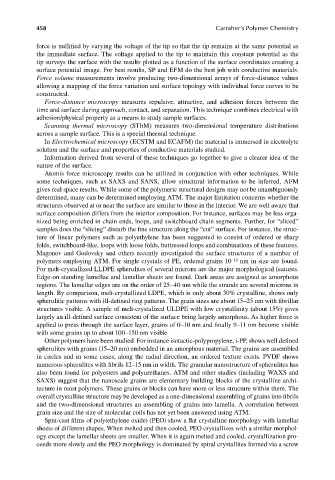Page 495 - Carrahers_Polymer_Chemistry,_Eighth_Edition
P. 495
458 Carraher’s Polymer Chemistry
force is nullified by varying the voltage of the tip so that the tip remains at the same potential as
the immediate surface. The voltage applied to the tip to maintain this constant potential as the
tip surveys the surface with the results plotted as a function of the surface coordinates creating a
surface potential image. For best results, SP and EFM do the best job with conductive materials.
Force volume measurements involve producing two-dimensional arrays of force-distance values
allowing a mapping of the force variation and surface topology with individual force curves to be
constructed.
Force-distance microscopy measures repulsive, attractive, and adhesion forces between the
time and surface during approach, contact, and separation. This technique combines electrical with
adhesion/physical property as a means to study sample surfaces.
Scanning thermal microscopy (SThM) measures two-dimensional temperature distributions
across a sample surface. This is a special thermal technique.
In Electrochemical microscopy (ECSTM and ECAFM) the material is immersed in electrolyte
solution and the surface and properties of conductive materials studied.
Information derived from several of these techniques go together to give a clearer idea of the
nature of the surface.
Atomis force microscopy results can be utilized in conjunction with other techniques. While
some techniques, such as SAXS and SANS, allow structural information to be inferred, AFM
gives real space results. While some of the polymeric structural designs may not be unambiguously
determined, many can be determined employing ATM. The major limitation concerns whether the
structures observed at or near the surface are similar to those in the interior. We are well aware that
surface composition differs from the interior composition. For instance, surfaces may be less orga-
nized being enriched in chain ends, loops, and switchboard chain segments. Further, for “sliced”
samples does the “slicing” disturb the fine structure along the “cut” surface. For instance, the struc-
ture of linear polymers such as polyethylene has been suggested to consist of ordered or sharp
folds, switchboard-like, loops with loose folds, buttressed loops and combinations of these features.
Magonov and Godovsky and others recently investigated the surface structures of a number of
–12
polymers employing ATM. For single crystals of PE, ordered grains 10 nm in size are found.
For melt-crystallized LLDPE spherulites of several microns are the major morphological features.
Edge-on standing lamellae and lamellar sheets are found. Dark areas are assigned as amorphous
regions. The lamellar edges are on the order of 25–40 nm while the strands are several microns in
length. By comparison, melt-crystallized LDPE, which is only about 30% crystalline, shows only
spherulitic patterns with ill-defined ring patterns. The grain sizes are about 15–25 nm with fi brillar
structures visible. A sample of melt-crystalized ULDPE with low crystallinity (about 15%) gives
largely an ill-defined surface consistent of the surface being largely amorphous. As higher force is
applied to press through the surface layer, grains of 0–10 nm and finally 9–11 nm become visible
with some grains up to about 100–150 nm visible
Other polymers have been studied. For instance isotactic-polypropylene, i-PP, shows well defi ned
spherulites with grains (15–20 nm) embedded in an amorphous material. The grains are assembled
in circles and in some cases, along the radial direction, an ordered texture exists. PVDF shows
numerous spherulites with fibrils 12–15 nm in width. The granular nanostructure of spherulites has
also been found for polyesters and polyurethanes. ATM and other studies (including WAXS and
SAXS) suggest that the nanoscale grains are elementary building blocks of the crystalline archi-
tecture in most polymers. These grains or blocks can have more or less structure within them. The
overall crystalline structure may be developed as a one-dimensional assembling of grains into fi brils
and the two-dimensional structures an assembling of grains into lamella. A correlation between
grain size and the size of molecular coils has not yet been answered using ATM.
Spin-cast fi lms of poly(ethylene oxide) (PEO) show a flat crystalline morphology with lamellar
sheets of different shapes. When melted and then cooled, PEO crystallizes with a similar morphol-
ogy except the lamellar sheets are smaller. When it is again melted and cooled, crystallization pro-
ceeds more slowly and the PEO morphology is dominated by spiral crystallites formed via a screw
9/14/2010 3:42:14 PM
K10478.indb 458 9/14/2010 3:42:14 PM
K10478.indb 458

